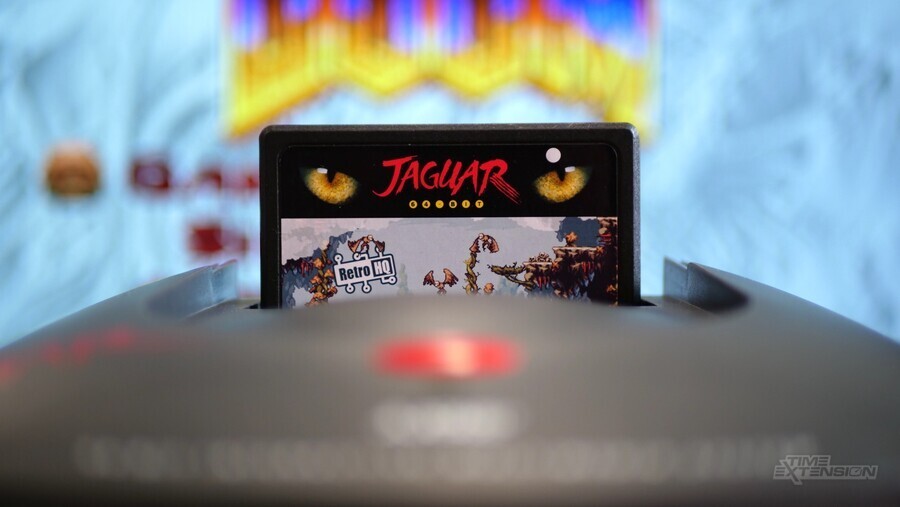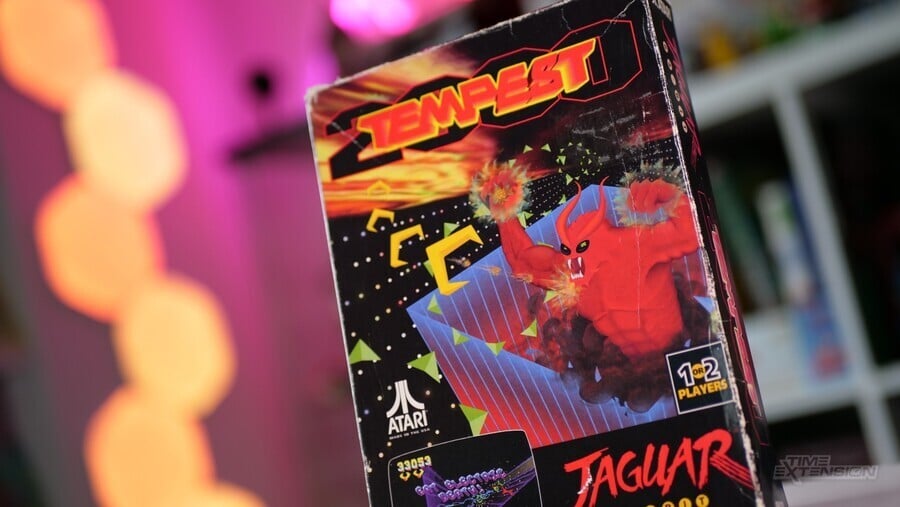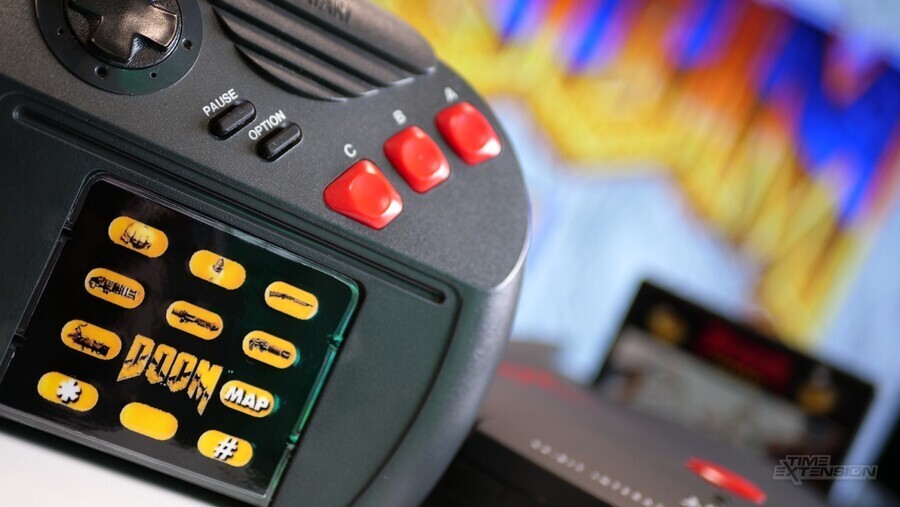Atari Jaguar: The Fan's Guide
Atari Jaguar: The Ultimate Accessory

While the Jaguar's library of titles is pretty meagre in comparison to other consoles, collecting every game is an expensive endeavour – even more so if you want the 'full' library including CD games, which requires the purchase of the rare and expensive Jaguar CD add-on.
Thankfully, RetroHQ has produced the GameDrive, a flash cart for the Jaguar which not only allows you to play officially-released cartridge titles and homebrew games, but also has support for CD-ROM titles, too. You can effectively have the entire Jaguar catalogue on a single MicroSD card using this device, which has upgradeable firmware and an easy-to-use UI.
The Jaguar GameDrive costs £168 / $180, so it's not cheap – but when you consider that titles like Tempest 2000 can cost around £50 in complete form, it still represents good value for money if you want to experience the Jag's entire library of games.
Collecting For The Atari Jaguar Today

Jaguar fan Shinto runs The Atari Jaguar Game by Game Podcast and is running through the console's library one game at a time. Here, he shares with us his personal history with the Atari Jaguar and explains the appeal of collecting for the console.
I was crouched in front of the glass case near the front door of my local used video game store, looking through their small stacks of Atari 2600 cartridges for anything I didn't already own.
"You know, it's funny," the owner told me, "some of these Atari games we just can't keep in stock. Pac-Man and E.T.? They always sell pretty much immediately."
"Really?” I asked. “Those are among the most common carts out there."
"Oh, yeah. We've got stacks of Space Invaders and Combat in the back, but those don’t sell. I guess it's the notoriety that comes with some of them, Pac-Man and E.T. in particular. They're famously bad."
Atari sold nearly three million E.T. game cartridges, and the number exceeds eight million for Pac-Man. With retro video game collecting, I learned that day, notoriety sells. Scarcity sells, too. Either attribute can jack up the price. And in the Venn diagram of notoriety and scarcity, right there in the middle, you get collecting for the Atari Jaguar.
It didn’t take long for the Jaguar to become little more than a punchline in the industry press. I would read glowing coverage in the recycled photons of Atari Explorer Online, but then turn to the pages of Electronic Gaming Monthly and find scathing reviews and opinion pieces. While I agreed with the former, popular opinion favoured the latter, and in the end, the Atari Jaguar was a commercial failure. It was the console so bad that it destroyed a one-time industry juggernaut, just as Pac-Man and E.T. were so bad that they alone nearly killed video games forever. Or so the legends go.
In the late '90s, stores couldn’t get rid of their Jaguar stock fast enough. At one point, Electronics Boutique stores in the UK were closing out all games and accessories for a single pound each. I bought most of my Jaguar collection earlier, usually at full retail, but still availed myself of these closeout prices to buy a second Jaguar console for $25, just to strip the motherboard out and hang it on the wall in my office. Not only did it look cool up there, but it was still functional, and I would occasionally play a $10 copy of Tempest 2000 with a $5 controller.
Since then, though, the tide has certainly turned. Until researching the cost of Jaguar games twenty years later for my work on the Atari Jaguar Game by Game Podcast, I had no idea how expensive these games had become. Cartridges like Rayman and Atari Karts, which entered my collection just like any other, were now fetching hundreds of dollars on eBay. I was dumbfounded. When did the Jaguar and its games transition from the bargain bin to the premium table?
Many listeners, throughout my years of working on the podcast, have asked me where the best place would be to buy Jaguar games. And there's no good answer. Sure, you can find most anything on eBay, but the convenience will cost you. Games do pop up on Amazon from time to time, but these are often even more expensive than eBay. There are exceptions, though; for example, long-time Atari vendor B&C Computer Visions, known as "myatari" on eBay, sells new old stock at fair prices.

I usually point people to the GOAT store, which has historically exhibited reasonable pricing and accurate descriptions. And if you don’t mind venturing away from a convenient storefront, you may also be able to find Jaguar items for sale at Best Electronics. Have your e-mail client handy.
I have seen reproduction Jaguar cartridges for sale on eBay and Etsy, and while these are usually labelled as such, they are nonetheless shady and illegal. As eager as some of my listeners have been to acquire a certain game, they have told me specifically that they would like to avoid reproductions, and I can’t blame them. More troubling are sellers, especially on eBay, offering Jaguar homebrew games on cartridges without the permission of the author. You may need to vet these listings a bit before snapping them up.
There are companies producing legal, modern homebrew Jaguar games, and these are often found off the beaten path at places like atariage.com, songbird-productions.com, and gooddealgames.com. I've seen cartridges readily available at such storefronts appear on eBay at inflated prices, so especially for homebrew titles, it usually pays to find the original publisher. Furthermore, on the topic of homebrew games, Jaguar owners now have a convenient way to play dozens of free homebrew titles using a relatively recent microSD cartridge from RetroHQ called the Jaguar GameDrive. It’s actively being produced and sold throughout the United States and Europe.
It’s funny, and more than a little ironic, that the Atari Jaguar is in demand now largely because it wasn’t in demand in the '90s. It’s a unique and distinctive console with an often-eclectic game library, a controller unlike any other, and an active homebrew scene. But supplies are limited, especially so if you are interested in the Jaguar CD add-on which was produced in far fewer quantities than the console itself. In a way, I lucked out by buying pretty much everything Jaguar-related back when it was new, when the Jaguar was considered a lacklustre oddity by many. Before the notoriety truly took hold.
Caring For Your Atari Jaguar
Simon Lock (also known by his online handle Aergan) is something of a wizard when it comes to resurrecting vintage gaming hardware. He has repaired and revived more gaming platforms than many people have had hot dinners and explains here what to look for when you're buying a Jaguar, how to care for it and what to do if you find one that's dead.
Time Extension: What kind of technical problems do Jaguars suffer from?
Simon Lock: How long do you have? Here are a few of the most notable problems relating to the system:
- Cracked solder joints for DC Input (Power)
- Some units have poor solder penetration for the DC input socket (typically later models but I don’t get sent enough to confirm) which are prone to cracking with physical force or over time. This issue is more commonly encountered on the Jaguar-CD unit.
- Dust/debris/moisture/oxidation/bugs
- Due to design and cost-saving decisions by Atari, the Jaguar is very prone to malfunctioning due to dirt, debris and oxidation. The cartridge slot has no covering or door system to prevent anything from falling inside, requiring use of deoxidation and/or electrical contact cleaning products. For those not using RF output, rather than use an appropriate AV Out connector implementation, Atari opted to have an exposed PCB edge connector. This is prone to poor contact issues as well as leaving critical areas of the system exposed to misuse. Typically there is nothing to prevent someone plugging the correct connector in upside down as well. Due to implementing a metal Faraday cage approach to the mainboard inside the shell (along with a piece of insulating paper card in the bottom to prevent electrical shorts during heavy cartridge insertion), the system is prone to moisture build-up if stored in humid or cold environments. It’s not uncommon to find 6 and 8-legged creatures inhabiting the carded sheet if not properly stored.
- Main 5V Voltage regulator
- The main 5V voltage regulator on the mainboard is involved in most (fatal) system failures. Due to the design and placement, all heat output from it is partially absorbed by two adjacent electrolytic capacitors. Due to age and constant exposure to heat, these can fail with fatal consequences to the system. It is not known whether the voltage regulator fails first or is just a symptom of the two capacitors failing. When a failure occurs, it often leads to sending DC input (9V) to the 5V output rail, causing typically irreparable damage to the system as parts are either prohibitively expensive or unobtainable without another donor system. I would advise that this part and the two adjacent capacitors are replaced on every system. The Jaguar has another secondary voltage regulator but this is unrelated to this specific issue.
- PSU
- The original PSU is prone to age-related issues that could cause increased heat output of the mentioned main 5V regulator. Given this issue and my encounters with OEM Atari PSUs in general, I would advise seeking a reputable and tested compatible replacement. Warning: Using the incorrect PSU polarity will also cause irreparable damage as there is no adequate protection from doing so.
- Controller port pins
- Like many systems, the controller pins are exposed. This means that they can be easily bent or snapped due to misuse or impact damage. If the console is dropped with a controller plugged in, this can cause the outer port casing to crack.
What's the Jaguar like to work on from a repair perspective?
It’s not my idea of a fun evening. The system can be time-consuming to get into due to the metal cage enclosing the mainboard inside the shell, which uses twisted metal tabs for assembly. The situation can be made infinitely worse if someone else has attempted it before then given up.
Replacement of through-hole components is made more challenging than it needs to be due to the entire board having been designed as thermal relief. The result is that removal without adapted techniques or expensive equipment can be a miserable experience for the person tasked with the job. I have encountered a few cases of poor work due to this issue.
Once the board is out, rarely is there any natural physical evidence of a failure unless the capacitor next to the main voltage regulator has burst. This can lead to time-consuming issues with fault finding as the system (due the complexity of the architecture) will operate it’s LED if a cartridge is inserted and power is present to the voltage regulator; regardless of it’s output operation.
Cartridge slot physical damage has been a common encounter for “junk” systems. Replacing them is possible with the correct tooling but it can be a very time-consuming process.
Currently, I recommend replacing the main voltage regulator, two adjacent capacitors, reflowing the DC input socket, ordering a reputable replacement PSU tested for the system and treating contacts with Caig Deoxit. This is the minimum to prolong working or repair unreliable systems.
What should prospective buyers look out for when purchasing a Jaguar today?
Assume no work has been done to the system unless photographic evidence can be provided and factor that into your decision. Visually inspect the cartridge slot for excessive wear, damage and cleanliness. Check the controller ports are present, straight, not discoloured and the casing is not cracked. Again, highly recommend using a reputable and tested compatible modern replacement PSU with the system. Unless provided, you will likely need to purchase a separate custom-made video cable or solution to get Composite Video or RGB output from the system. If you are provided with Cybermorph, you will have instant buyer's remorse after purchase. (If Jaguar CD, same joke but with Blue Lightning.)
What kind of options do collectors have when it comes to safeguarding their Jaguar console, and what can they do to ensure it has the longest possible lifespan?
Whilst no authority on the subject, I would recommend that any console is stored in a temperature and humidity stable location. External property areas (e.g. attics, garages, sheds) are extremely poor for this console. If possible, when storing the console consider using moisture-absorbing products (especially if in storage boxes with a tight seal). Such absorbing products should be cycled or replaced throughout the year to remove built-up moisture. Ensure minimum servicing is carried out as mentioned above. Do not wrap any console cords around the console or controllers. Cords have softeners in their chemical make-up to keep them flexible; when tightly wrapped around plastic, these break down the surface leading to permanent indentations and damage.






Comments 14
Brilliant article as usual, still would of been great to see the Jag pushed to its full potential. Bad marketing, poor software, always goes to show games will make or break a system seen it many times before. Gameboy destroyed the Lynx and the Gamegear, thanks to Tetris, Super Mario, and that was just for starters.
Loving these articles! These were the types of things I wished I was able to read about when I was a kid!
NINJA APPROVED
Really thorough and a good read - thanks!
I am a proud owner of the Jaguar Toilet Seat, but I only have 2 games
Excellent work. Easily the most comprehensive write-up of the Jaguar I've ever seen. Bravo!
Great article and a strange little console, the power vs Saturn makes me laugh as that's a long way from being true. Though the sound chip theoretically doing other tasks I think is correct, I'm pretty sure Doom uses it for other tasks and that's why it has no music.
It's Doom port is one of the very best of the time and the foundations of Doom console ports for a while. Tempest 2000 is another great game with a stellar soundtrack but sadly it was never realistically going to succeed.
I am looking forward to the Atari 50th anniversary collection which includes some Jaguar games, later this year
Excellent article. I know very little about the Jaguar and its history so this was very educational and interesting. Thanks!
Good timing! I’ve recently been bingeing on Jaguar: Tempest 2000, Iron Soldier, and Super Burnout, all excellent, with some Val D’Isere Skiing and Snowboarding on the side. It’s a neat system that I wish had survived just a little longer.
I wanted one of these, think my parents got tired of spending their money on the ‘latest thing’. I never got one.
Good read this article!
Defender 2000 , Tempest 2000 and Doom were the only games i ever played on the console. For me, the rest were terrible.
Such a shame
This was a terrific article to read i would love to see more Atari Jaguar content on the site. I would especially love to see "making of" articles for these Jaguar games, as we know almost next to nothing about their development process:
Sorry for the wall of text XD but i'm a Jaguar enthusiast
I remember this console coming out, the hype on bad influence and then the lack of support for software and any well known titles. In some ways it was abused in the same way as the 32x - just used to make cheap 16 but ports which then did nothing to convince you to buy into the next gen. At least they got the price right.
Maybe good to note , now it is republished that the emulation of the jaguar is finally get there https://www.youtube.com/watch?v=_7E3EErUMuU
I bought a cheap jag 10 years ago for tempest 2k, such a brilliant game, feels even better than the vita or ps4 version
I wanted one so bad when I was a kid and poor. Could only afford one system and was usually a handheld. Now I have all the systems but no time to play. I wish there would be more challengers to the big three. Some innovation.
Show Comments
Leave A Comment
Hold on there, you need to login to post a comment...